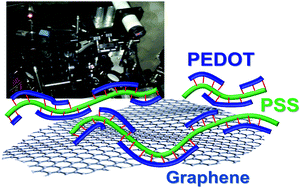当前位置:
X-MOL 学术
›
J. Mater. Chem. C
›
论文详情
Our official English website, www.x-mol.net, welcomes your
feedback! (Note: you will need to create a separate account there.)
Thermo-optical characterization and thermal properties of graphene–polymer composites: a review†
Journal of Materials Chemistry C ( IF 5.7 ) Pub Date : 2017-08-14 00:00:00 , DOI: 10.1039/c7tc01719g Reg Bauld 1, 2, 3, 4 , Dong-Yup William Choi 1, 2, 3, 4 , Paul Bazylewski 1, 2, 3, 4, 5 , Ranjith Divigalpitiya 4, 5, 6 , Giovanni Fanchini 1, 2, 3, 4, 7
Journal of Materials Chemistry C ( IF 5.7 ) Pub Date : 2017-08-14 00:00:00 , DOI: 10.1039/c7tc01719g Reg Bauld 1, 2, 3, 4 , Dong-Yup William Choi 1, 2, 3, 4 , Paul Bazylewski 1, 2, 3, 4, 5 , Ranjith Divigalpitiya 4, 5, 6 , Giovanni Fanchini 1, 2, 3, 4, 7
Affiliation

|
Graphene–polymer composites have shown great promise as thermal interface materials to replace state-of-the-art silver-grease thermal pastes. A deeper understanding of their inherent thermal properties irrespective of their interfacial thermal resistivity with other systems is required to develop them with a sufficient degree of generality for a host of thermal applications. This also requires that thermal transport measurements need to be carried out contactlessly. Thermo-optical characterization methods based on the photothermal effect are valuable contactless techniques for determining the thermal properties of thin-film materials without the need to transfer heat from other media to the sample under investigation. However, they require a careful and often complex modeling procedure to extract thermal properties of the film–substrate-environment system, and the results they provide are often depending on the specific model used to interpret the measured data. In this article, we offer a review of photothermal and thermo-optical methods, with a focus on the recent progress in using them for developing the thermal properties of graphene–polymer composites. We discuss some of the methods used for aligning graphene platelets with each other, to improve their directional thermal conductivity, and to understand how thermo-optical pump–probe techniques can be used for characterizing such systems, with PEDOT:PSS–graphene composite systems as working examples.
中文翻译:

石墨烯-聚合物复合材料的热光学表征和热性能:综述†
石墨烯-聚合物复合材料作为热界面材料已显示出巨大的希望,可以代替最新的银脂导热膏。不管它们与其他系统的界面热阻如何,都需要对它们固有的热性能有更深入的了解,才能以足够的通用性开发它们以用于许多热应用。这也要求热传输测量需要非接触地进行。基于光热效应的热光学表征方法是有价值的非接触式技术,可用于确定薄膜材料的热性能,而无需将热量从其他介质传递到正在研究的样品中。然而,他们需要仔细且通常很复杂的建模程序来提取膜-基底-环境系统的热性能,并且它们提供的结果通常取决于用于解释测量数据的特定模型。在本文中,我们对光热和热光方法进行了综述,重点是在利用它们来发展石墨烯-聚合物复合材料的热性能方面的最新进展。我们讨论了一些用于使石墨烯血小板彼此对齐,改善其方向热导率的方法,并了解了如何使用热光泵浦探针技术来表征此类系统,以及PEDOT:PSS–石墨烯复合系统,例如:工作实例。在本文中,我们对光热和热光方法进行了综述,重点是在利用它们来发展石墨烯-聚合物复合材料的热性能方面的最新进展。我们讨论了一些用于使石墨烯血小板彼此对齐,改善其方向热导率的方法,并了解了如何使用热光泵浦探针技术来表征此类系统,以及PEDOT:PSS–石墨烯复合系统,例如:工作实例。在本文中,我们对光热和热光方法进行了综述,重点是在利用它们来发展石墨烯-聚合物复合材料的热性能方面的最新进展。我们讨论了一些用于使石墨烯血小板彼此对齐,改善其方向热导率的方法,并了解了如何使用热光泵浦探针技术来表征此类系统,以及PEDOT:PSS–石墨烯复合系统,例如:工作实例。
更新日期:2017-08-14
中文翻译:

石墨烯-聚合物复合材料的热光学表征和热性能:综述†
石墨烯-聚合物复合材料作为热界面材料已显示出巨大的希望,可以代替最新的银脂导热膏。不管它们与其他系统的界面热阻如何,都需要对它们固有的热性能有更深入的了解,才能以足够的通用性开发它们以用于许多热应用。这也要求热传输测量需要非接触地进行。基于光热效应的热光学表征方法是有价值的非接触式技术,可用于确定薄膜材料的热性能,而无需将热量从其他介质传递到正在研究的样品中。然而,他们需要仔细且通常很复杂的建模程序来提取膜-基底-环境系统的热性能,并且它们提供的结果通常取决于用于解释测量数据的特定模型。在本文中,我们对光热和热光方法进行了综述,重点是在利用它们来发展石墨烯-聚合物复合材料的热性能方面的最新进展。我们讨论了一些用于使石墨烯血小板彼此对齐,改善其方向热导率的方法,并了解了如何使用热光泵浦探针技术来表征此类系统,以及PEDOT:PSS–石墨烯复合系统,例如:工作实例。在本文中,我们对光热和热光方法进行了综述,重点是在利用它们来发展石墨烯-聚合物复合材料的热性能方面的最新进展。我们讨论了一些用于使石墨烯血小板彼此对齐,改善其方向热导率的方法,并了解了如何使用热光泵浦探针技术来表征此类系统,以及PEDOT:PSS–石墨烯复合系统,例如:工作实例。在本文中,我们对光热和热光方法进行了综述,重点是在利用它们来发展石墨烯-聚合物复合材料的热性能方面的最新进展。我们讨论了一些用于使石墨烯血小板彼此对齐,改善其方向热导率的方法,并了解了如何使用热光泵浦探针技术来表征此类系统,以及PEDOT:PSS–石墨烯复合系统,例如:工作实例。











































 京公网安备 11010802027423号
京公网安备 11010802027423号